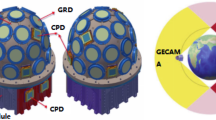Abstract
Background
The Gravitational wave high-energy Electromagnetic Counterpart All-sky Monitor (GECAM) is primarily designed to spot gamma-ray bursts corresponding to gravitational waves. In order to achieve stable observations from various astronomical phenomena, the payload performance need to be monitored during the in-orbit operation.
Method
This article describes the design and implementation of GECAM satellite payload performance monitoring (GPPM) software. The software extracts the payload status and telescope observations (light curves, energy spectrums, characteristic peak fitting of energy spectrums, etc) from the payload data. Considering the large amount of payload status parameters in the engineering data, we have designed a method of parameter processing based on the configuration tables. This method can deal with the frequent changes of the data formats and facilitate program maintenance. Payload status and performance are monitored through defined thresholds and monitoring reports. The entire software is implemented in python language and the huge amount of observation data is stored in MongoDB.
Conclusion
The design and implementation of GPPM software have been completed, tested with ground and in-orbit payload data. The software can monitor the performance of GECAM payload effectively. The overall design of the software and the data processing method can be applied to other satellites.






Similar content being viewed by others
Notes
FITS format is a common data storage format in the astronomical field, for details see the web site of https://fits.gsfc.nasa.gov/.
CSV files store tabular data (numbers and text) in plain text form.
The 37.4 keV and 1470 keV intrinsic gamma-ray lines of \(\text {LaBr}_{3}\):Ce can be resolved from in-flight backgrounds. The galactic 511 keV gamma-ray line also can be resolved [7].
References
B.P. Abbott, R. Abbott, T.D. Abbott et al., Observation of gravitational waves from a binary black hole merger. Phys. Rev. Lett. 116(6), 061102 (2016)
P. Mészáros, D.B. Fox, C. Hanna et al., Multi-messenger astrophysics. Nat. Rev. Phys. 1(10), 585–599 (2019)
M. Mostafá, The astrophysical multi-messenger observatory network. Nat. Rev. Phys. 2(9), 446–448 (2020)
X.B. Han, K.K. Zhang, J. Huang et al., GECAM satellite system design and technological characteristic. Sci. Sin. Phys. Mech. Astron. 50(12), 129507 (2020)
X.Q. Li, X. Wen, Z.H. AN et al., The GECAM and its payload. Sci. Sin. Phys. Mech. Astron. 50(12), 129508 (2020)
P. Lv, S.L. Xiong, X.L. Sun et al., A novel gamma-ray detector for GECAM, in International Conference on Technology and Instrumentation in Particle Physics (Springer, Singapore, 2017), pp. 3–7
D. Zhang, X. Li, S. Xiong et al., Energy response of GECAM gamma-ray detector based on LaBr 3: Ce and SiPM array. Nucl. Instrum. Methods Phys. Res. Sect. A Accel. Spectrom. Detect. Assoc. Equip. 921, 8–13 (2019)
J.Y. Liao, Q. Luo, Y. Zhu et al., The localization method of GECAM and simulation analysis. Sci. Sin. Phys. Mech. Astron. 50(12), 129510 (2020)
W. Chen, L.M. SONG, S.J. ZHENG et al., Introduction of the scientific application system of GECAM. Sci. Sin. Phys. Mech. Astron. 50(12), 129512 (2020)
X.Y. Song, S.L. Xiong, Q. Luo et al., Introduction to gamma-ray burst data analysis algorithm and software tools for GECAM. Sci. Sin. Phys. Mech. Astron. 50(12), 129511 (2020)
Official website of Mysql. https://www.mysql.com/
Official website of Mongodb. https://www.mongodb.com/
B. Jose, S. Abraham, Performance analysis of NoSQL and relational databases with MongoDB and MySQL. Mater. Today Proc. 24, 2036–2043 (2020)
K.J. Millman, M. Aivazis, Python for scientists and engineers. Comput. Sci. Eng. 13(2), 9–12 (2011)
Acknowledgements
This work is supported by the Strategic Priority Research Program of Chinese Academy of Sciences (Grant Nos. XDA15360300, XDA15360302 and XDB23040400).
Author information
Authors and Affiliations
Corresponding author
Rights and permissions
About this article
Cite this article
Zhang, P., Ma, X., Huang, Y. et al. The design and implementation of GECAM satellite payload performance monitoring software. Radiat Detect Technol Methods 6, 3–11 (2022). https://doi.org/10.1007/s41605-021-00283-4
Received:
Revised:
Accepted:
Published:
Issue Date:
DOI: https://doi.org/10.1007/s41605-021-00283-4




